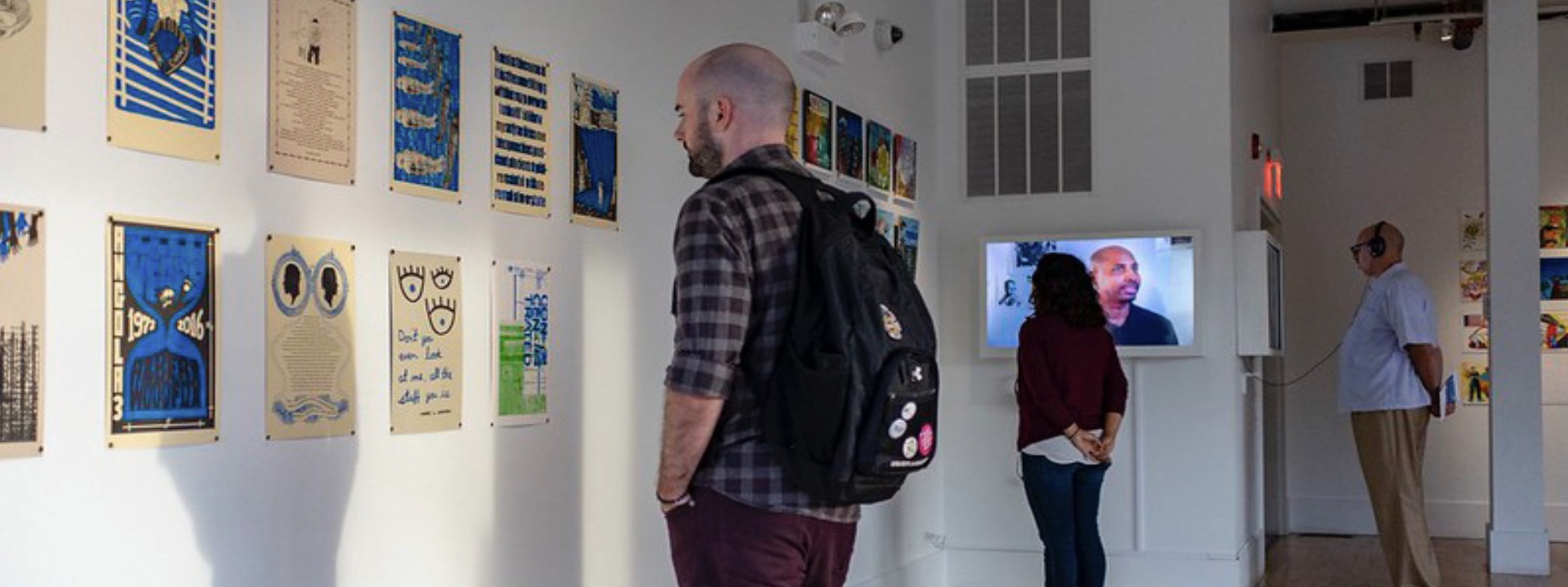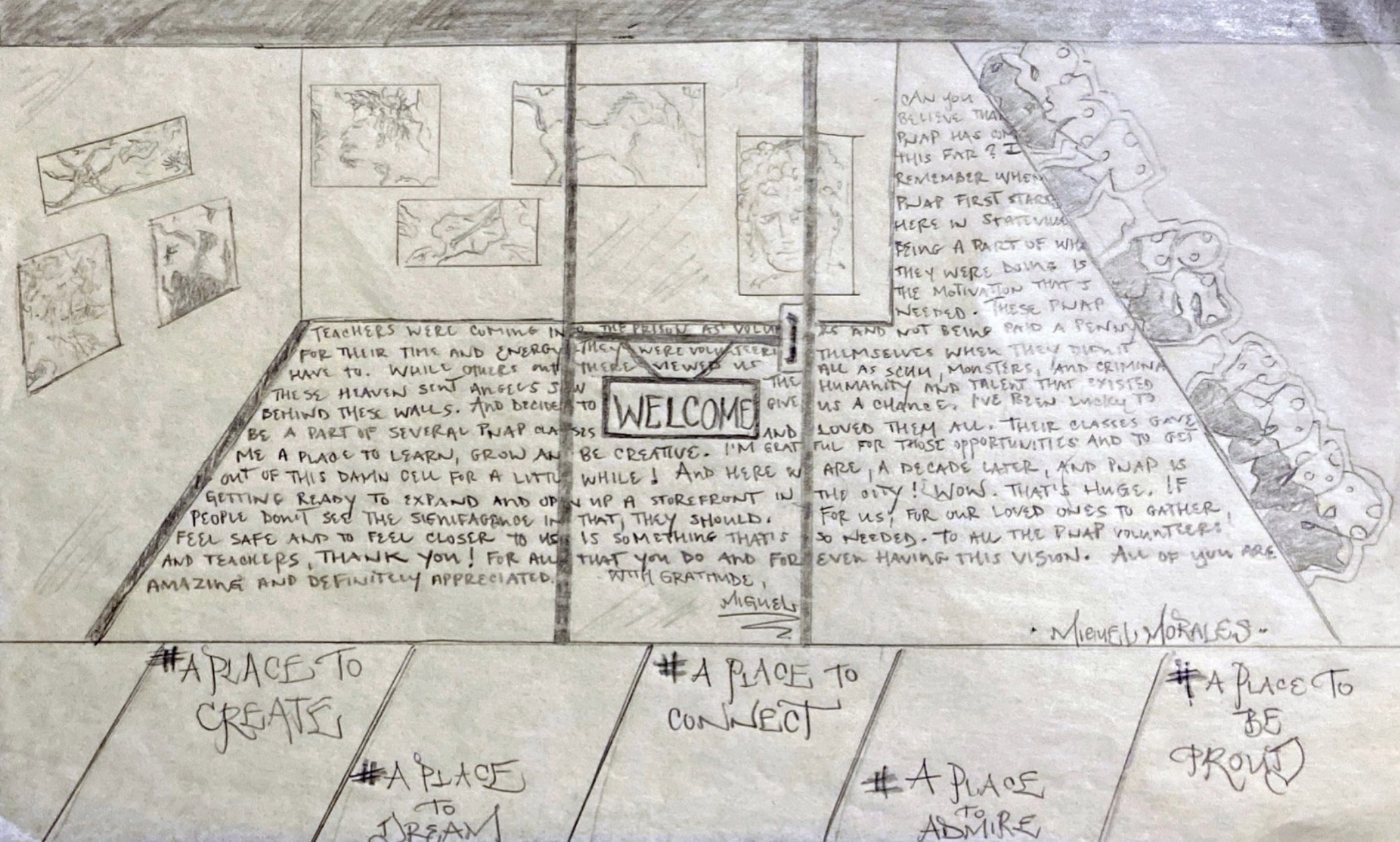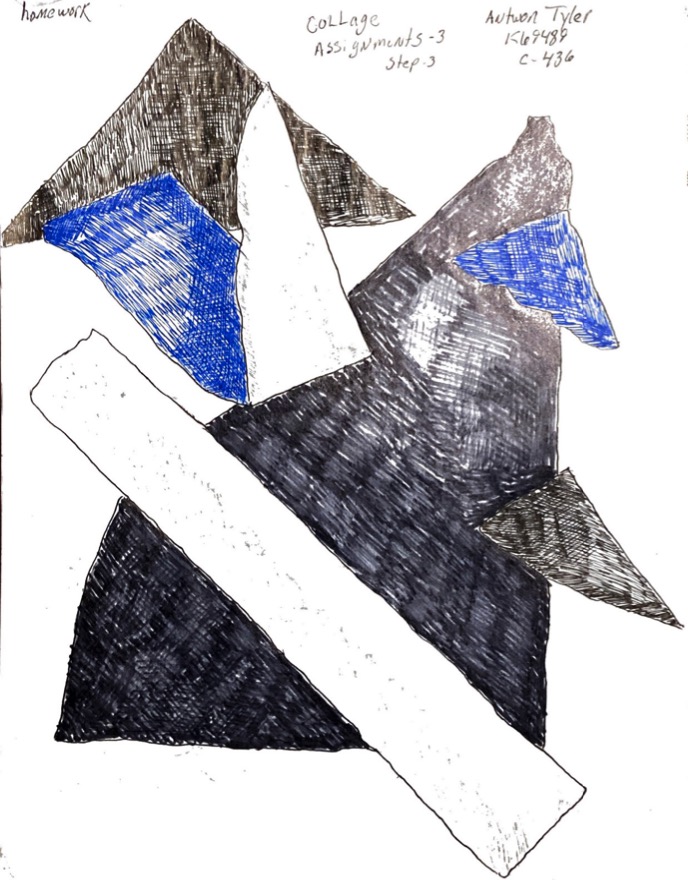
AWF Grantee Prison + Neighborhood Arts/Education Project and the Walls Turned Sideways project
December, 2021
A 2021 report on the outcomes of community-based research designed to imagine and create an art gallery + community center dedicated to artists and communities impacted by incarceration.
Cover image: Volunteers paint a mural designed by artist Devon Terrell at Stateville prison at DuSable Musueum of African American History, 2021.
What
Walls Turned Sideways is an art gallery and community space dedicated to artists and communities impacted by incarceration. Through exhibitions, political education workshops, and a community care component, Walls Turned Sideways will offer a space to experience and create art, share resources, and build solidarity with families of incarcerated people.

Damon Locks talks to audiences at The Long Term exhibition at Arts and Public Life.
Who
Walls Turned Sideways has been researched and developed by Pablo Mendoza and Sarah Ross. An advisory board of artists, activists, and formerly incarcerated people shaped the work and direction of the project. The advisory board includes: Eric Blackmon, Kevin Blumenberg, Monica Cosby, Andres Hernandez, Aaron Hughes, Raphel Jackson, Tess Landon, Damon Locks, Joseph Mapp, Muneca Mulero, Anna Martine Whitehead, and Amanda Williams.
Why
More than a decade ago, the Prison + Neighborhood Arts/Education Project (PNAP) started with the vision of connecting inside communities at Stateville prison and outside neighborhoods in Chicago through classes, exhibitions, and events. PNAP teaches classes at Stateville with the guiding principle that art, poetry, and performance created together with incarcerated artists initiates both dialogue and action about the most critical issues of our time. Incarceration removes people from neighborhoods without adequately analyzing the social, economic, and political structures that produce the many conditions of which crime is but a symptom. PNAP’s classes, exhibtions, and events directly respond to these concerns through close collaborations with artists and poets inside prison and the communities they leave behind.
Walls Turned Sideways is an important outgrowth of this work that aims to provide a space to consistently show art of incarcerated and formerly incarcerated artists; deepen relationships with families and children of incarcerated people; and create communities of care around the very traumatic conditions of incarceration.

The Long Term exhibition, 2019
Background
Between February and August of 2021, Pablo Mendoza and Sarah Ross conducted research to learn from allied organizations and activists, families of incarcerated people, and currently incarcerated people. Through interviews and surveys we asked: is there a need for an art and community space for families of incarcerated folks? If so, what should it look like and who/what should be involved in such a space? We wanted to know the needs and desires of people who would use the space, even if, due to incarceration, they might never visit it. In addition to interviews and surveys we took these ideas to Stateville prison in the form of a class, taught by Anna Martine Whitehead, Andres Hernandez, and Amanda Williams. The class thought about how to create liberatory spaces and what a community space their families would visit might be. Through these avenues of inquiry, creative engagement, and regular meetings with our Advisory Board, the overwhelming feedback we received was:
- There are few spaces in the city, and specifically on the Westside of Chicago, that connect with families and kids of incarcerated people through art, and there are no spaces specifically dedicated to this community.
- There is a need for a space where impacted communities can congregate and educate each other and their loved ones about experiences with incarceration.
- There is a need for a space for formerly incarcerated artists to show and sell their work.

Audiences listen to poetry readings at Uri Eichen Gallery at the Contingent Citizen exhibition, 2019;

Miguel Morales, Drawing from the class Making Space: Emancipatory Design, 2021.
Interviews with Organizers, Artists, and Allies
We interviewed more than 20 organizers, artists, and allies who generously shared their time and insights with us about everything from the nuts and bolts of running an organization, to problems and challenges we will certainly face. Below is a list of people we interviewed, along with important takeaways from our conversation.
Interviewees
Angela Taylor & Mike Tomas Garfield Park Community Council
Arewa Winters Justice for Families (of BLM)
Benny Lee National Alliance for the Empowerment of the Formerly Incarcerated
Cindy Eigler & Mark Clements Chicago Torture Justice Center Courtney Bowles & Mark Strandquist People’s Paper Coop Deana Lewis & Rachel Caidor Love & Protect
Delia Ramirez IL State Representative
Elena Quintana & Larry Barrett Institute for Public Safety and Social Justice
Julie Anderson Restore Justice Karen Reyes Firebird Community Arts
Kevin Blumenberg Accluvist Inc. Community Navigator; People’s Lobby Mass Liberation Community Organizer
Kimeco Robertson & Augie Torres READI Chicago
Kristiana Rey Colón Let Us Breathe Collective
Leah Gibson School of the Art Institute of Chicago, Art Therapy
Melissa Lorain Theatre Y
Omar Magana Open Center for the Arts Chicago
Orlando Mayorga The Justice Equity Opportunity Initiative, Lt. Gov. Office
Salome Chasnoff P.O. Box Collective Souzan Nasser MAMAS
Please note that the comments below are not direct quotes but rather excerpts from our working notes.
The space would be an important connection for families of impacted folks. Seeing the art of family members would be like a visitation without a visitation. The presence goes a long way.
-- Benny Lee, National Alliance for the Empowerment of the Formerly Incarcerated
There are lots of victim support groups, not a lot of family support groups. There is no transparency at IDOC, you don’t know what’s going on. It would be useful for family members to know what is happening at the different prisons.
-- Julie Anderson, Restore Justice
The first thing that popped into my mind is the Black Panthers Headquarters. Yes the space would be helpful--folks could get resources and connect to others going through what they are going through with resource support and moral support.
-- Larry Barrett, Institute for Public Safety and Social Justice
Westside is territorial, you have to get buy- in from the community. Be authentic about how the community can organize the space. If there are artists in the community who want to use the space, make sure that they can use it.
-- Arewa Winters, Justice for Families (of BLM)
Surveys
In the spring of 2021 we surveyed incarcerated artists at Stateville and families of incarcerated people. Pablo Mendoza compiled and analyzed the surveys. A preliminary reading of the survey responses, taking in a sample size of 33% of the total responses, answered our central questions. 100% of those participants found a great need for a community space like the one envisioned by Walls Turned Sideways. When incarcerated artists were asked if their loved ones would visit such a space, they answered in the affirmative. While some participants acknowledged that it would be difficult for them to visit due to travel distance, they still agreed that an art and community space of this kind is needed. Below are some survey responses from incarcerated artists and families and friends of currently incarcerated people.
Art is just as important to the families. This is important to us as a family because of the excitement it brings not only my husband but our children and family, as well. It also brings normalcy into our lives.
-- Melly Rios
My daughter visited one of the art exhibits, and she was super excited to be a part of something I was involved [in]. [M]e being incarcerated for so long, it connects me to the younger generation in my family [which] really hasn’t had a chance to really meet me.
-- Johnny Taylor
I’m not from Chicago, I’m from Texas, but regardless of where art is shown,it’s an indicator that someone has a voice that wants and needs to be heard.
-- Manuel “Manny” Gonzalez
Survey participants were offered the chance to envision what a gallery/community space should look like and what kind of programming Walls Turned Sideways should offer. Many of them seized this opportunity and thought of programming that they would like to see happen at the space. Below are some suggestions:
writing workshops focused on institutional violence and negotiating the trauma of surviving and perpetrating violence and moving towards creating language for restoration of freedom
-- Anonymous
trainings - how to advocate, support, get funding, talks with local grassroots organizations. [Creating] protest posters
-- Anonymous
a space for children to deal with the void of an incarcerated parent and a healing therapeutic space for the processing of it all
-- Yaneth Flores
an open [mic] night for other outside poets to join in and express themselves
-- Johnny Taylor
Our interviews and surveys confirmed the importance of a cultural space dedicated to people impacted by incarceration. The walls that separate friends and family members from loved ones in prisons are just one of many ways incarceration creates deep disconnections for families, communities, and the person incarcerated. Further, a recent report by the Taskforce on Children of Incarcerated Parents states that children and caregivers experience a range of strains when a parent is incarcerated--emotional, financial, etc.--and that “children of incarcerated parents are at a greater risk to be disenfranchised from civic or political participation.” We believe that Walls Turned Sideways will help bridge the gap, connecting people to culture, education, and political enfrancisement.
Making Space: Emancipatory Design Class at Stateville Prison
In the summer of 2021, Anna Martine Whitehead, Andres Hernandez, and Amanda Williams taught a workshop at Stateville (via correspondence due to COIVD) called Making Space: Emancipatory Design with the intention of visioning a future Walls Turned Sideways gallery and community space. The class read about historical communtiy organizations and the spaces they made together. Students crafted written and visual responses to explore what community spaces can do.
Images appearing throughout this report are from the class.

Antwon Tyler, Drawing from the class Making Space: Emancipatory Design, 2021.
Our Vision: Walls Turned Sideways
Based on our research and regular feedback from Advisory Board members we developed four program areas to create a dynamic and connected space.
Art, Writing, and Performance
created by artists at Stateville prison and artists in the city will anchor exhibitions in the gallery, while teaching artists and writers will host workshops in the community space. Each exhibition will host programming designed to bring together loved ones of incarcerated people and general audiences for art- making based on the themes of the exhibition.
Political Education
is a monthly series that will use popular education models to learn about criminal legal policy that impacts families of people locked up. We will collaborate with advocacy and legal organizations to support this series to offer revelant information to families and ways to stay involved. In addition, we will work with volunteer paralegals and lawyers to hold much-needed legal clemency and expungement workshops.
Community Building
will invite neighbors to lunches and dinners to talk about this work. We will make Walls Turned Sideways accessible to community groups in the area that need meeting spaces, exhibition spaces, etc. By offering our time to support community-driven work, even when its focus is not on issues of criminalization and incarceration or art, we believe we can build stronger alliances across communities and concerns.
Community Care
includes hosting transformative justice circles, work with healing practitioners and drop- in hours to support families, children, and formerly incarcerated people. For drop- in hours we will use the HOMAGO model (Hang Out, Make Art, Geek Out). This means having available art supplies and space, computers, and couches to make the space comfortable for organic connections and creations.
Conclusion
Our interviews, surveys, creative engagement, and lived experiences make abundantly clear that the crisis of incarceration exacerbates traumas and leaves them untreated. Incarceration disconnects and distances families and kids from their loved ones, strains relationships, and fosters isolation. There is a deep need to build and sustain community spaces that bring together people impacted by criminalization and incarceration in dynamic and creative ways.
Walls Turned Sideways proposes art as a tool to interrogate the stigmas of incarceration, strengthen collective identity, and reflect the beauty and resistance in communities impacted by incarceration. We envision a creative and critical engagement that will ensure access to art, political education, and bring people together in a supportive and mutually caring way.
Thank You
The Arts Work Fund generously supported our research. This exploratory research and outreach would not have been possible without their support. Thank you!
A huge thank you to our Advisory Board for time on zoom and in person, thinking through connections and ideas for this project.
Tempestt Hazel, Eric Blackmon, Ryan Griffis, Yanet Flores and many others gave additional time to support our visions. Jason LaFountain closely edited this report and Eliza Gonring and Sarah Ross co-designed it. Finally, thank you to the PNAP crew which always makes space to build connections and imagine the impossible.
More Sharing